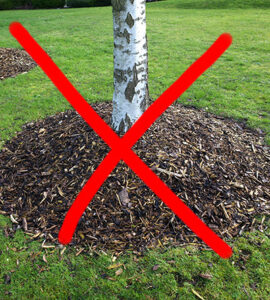
Planting a new tree is exciting. It’s the beginning of decades of beauty. Hopefully. Caring for newly planted trees is a bit more complex than many people think and can be vastly different than caring for other plants and flowers. Mulching techniques, fertilization needs, and many other care steps are not the same for trees. One source of information that is more reliable than any you can get is an expert Monmouth County tree company. There might be no other persons more knowledgeable about tree care in your area than a local tree company. They can give you recommendations on appropriate trees for your yard and situation, proper tree care, and most importantly, provide help for trees that are suffering. Follow these tips to prevent the sickness and death of your newly planted tree.
Mulching is Important to Brand New Trees

Applying a thick layer of mulch is not just important for your gardens. Wood chips help conserve water and prevent weeds when used correctly around the base of new trees. The key to your mulch being beneficial is all in the application. Volcano mulching is the term given to a mulching process that piles the highest amount of mulch up against the bark. The pile then slopes down away from the tree. This is the wrong way to mulch any tree, but especially a newly planted tree. It prevents the roots from being able to absorb water and can cause damage to the bark. The correct application of mulch is to put the mulch in a ring shape around the trunk with no mulch actually coming in contact with the tree. When applied this way, mulch effectively slows water-loss, insulates the soil against extreme temperatures, and helps deter pests.
Monmouth County Tree Company Says Skip the Fertilizer
Many people think that a growing tree would need extra fertilizing to give it a boost. While this works for flowers, fertilizing a very young tree can be very detrimental. A general rule of thumb is that trees less than one to two years old should not be fertilized. During their first years, trees are focused on establishing a strong root system. Fertilizers, especially those that are high in nitrogen, can boost leaf growth. Shifting the focus from building a strong root system to growing new limbs and leaves can ultimately lead to the death of a tree due to the reduced root growth. In addition, most trees get the nutrients they need from the surrounding soil and turf. If you have any concerns about the health of your soil, have it tested prior to planting anything.
Watering a Newly Planted Tree

Saplings have, understandably, smaller and fewer roots. This makes young trees vulnerable to receiving too few as well as too many resources. Watering is an important part of caring for a newly planted tree says Ben Bivins Tree Experts, the Monmouth County tree company we spoke with. Immediately after planting is the most important time to water a tree. It is better to compact the soil using water versus stomping the soil. Smooshing the soil with your feet can compact the soil too much preventing efficient uptake of nutrients by the roots. While mature trees require little to no watering outside of regular rainfalls, newly planted trees need frequent watering. However, it is also important to not overwater. Check the moisture level of the soil around the tree prior to watering to ensure you’re not overwatering.
The Great Debate About Stakes Settled by a Monmouth County Tree Company
There is a lot of debate about whether you need to stake a newly planted tree or not. The answer is not straight forward and it truly depends on a few factors. If you are planting a new tree in a very windy environment, staking may not be a bad idea. If you don’t need to stake a new tree for protection or support, you can probably skip it. Many articles that discuss new tree care don’t even mention stakes. Whether or not your new tree needs to be staked is based largely on the species of tree and the planting environment. Staking trees and other questions about what your new tree needs can be answered by any professional at a Monmouth County tree company.
We hope that with all this information on how best to care for your new tree, your new tree grows strong and healthy.
